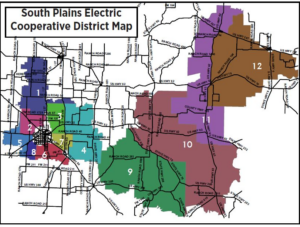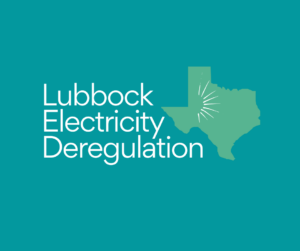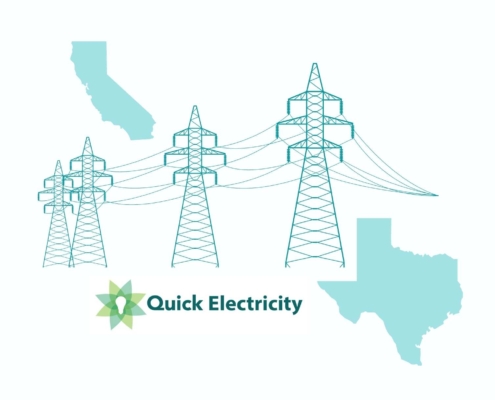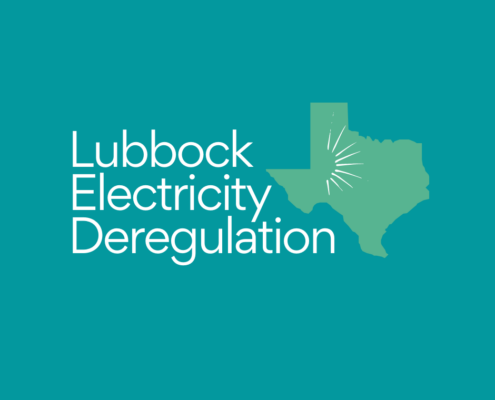Last Updated on April 17, 2023 by Mary Pressler
Lubbock’s Electric Transmission and Delivery
As you might have read in energy news, Lubbock is the first Texan city that is joining the competitive electricity market voluntarily. Texas deregulated it’s power sector in 2002, but participation was made optional for electric cooperatives and municipal power companies. This included the three largest municipal power companies in the state: CPS Energy (San Antonio), Austin Energy, and Lubbock Power & Light.
When a city switches from a municipal power company to the deregulated grid, there are many important changes.
A municipal power company sells you electricity, which can be generated with power plants that are owned directly or purchased from private generators. They are also in charge of local grid components: power lines, poles, transformers, substations, etc.
In a deregulated power grid, there are actually two types of companies involved. The difference between REPs and TDUs in Lubbock is the following:
- Retail electricity providers (REP): They sell you kilowatt-hours, which are priced according to an electricity plan.
- Transmission and distribution utility (TDU): The company in charge of the local grid, who charges a delivery fee for each kilowatt-hour purchased from REPs.
In any given location, you can choose among several REPs but there is only one TDU in charge of the grid. Having more than one TDU would mean having parallel grids in the same region, and this would represent a major waste of capital. LP&L will be Lubbock’s TDU.
Lubbock Electricity Rates
The following table compares average electricity prices for Lubbock, Dallas, and the state of Texas in general over the past six months (Source: EnergySage). Dallas is located in the Oncor service territory.
| Area | Monthly Bill ($) | Monthly Consumption (kWh) | Average kWh Price |
| Lubbock | $226 | 1,699 kWh | 13.30 cents/kWh |
| Dallas | $191 | 1,575 kWh | 12.13 cents/kWh |
| Texas (statewide) | $203 | 1,575 kWh | 12.89 cents/kWh |
For comparison, EnergySage reported a US average electricity price of 18 cents/kWh.
LP&L and the ERCOT Transition
Lubbock Power & Light has been the municipal electric company serving Lubbock since 1916. They are the third largest municipal utility in the Lone Star State after CPS Energy and Austin Energy. LP&L has more than 104,000 customers as of 2022, and a staff of over 300 employees. LP&L also manages over 4,900 miles of power lines and three power stations.
LP&L presented a deregulation plan to the City Council in December 2021, and the transition became official by unanimous vote in February 2022. LP&L started the process right away, and 70% of their customer base was connected to the ERCOT grid in May 2022. This represents 83,000 customers with a total load of around 470 MW, along with 120 MW of generation capacity. The remaining 30% of customers (around 24,000) remain under LP&L, and they will be connected to the ERCOT grid in May 2023.
In total, Lubbock’s transition to the deregulated electricity market adds 670 MW of load to the ERCOT grid, specifically in the Oncor service territory. By joining ERCOT, LP&L can avoid the construction of a new power plant that would have cost around $700 million.
What Role Will LP&L Play After Deregulation?
LP&L will remain in charge of the local transmission and distribution grid. LP&L will also remain in charge of smart meters. The main difference is that LP&L will no longer sell energy directly, and instead they will deliver the energy purchased from REPs (retailers).
What Does This Mean for Electricity Consumers in Lubbock?
As of October 2022, LP&L published the following rates for residential customers. Note that PCRF stands for Power Cost Recovery Factor:
- Fixed fee: $8.07 per month
- Energy charge: $0.03381 per kWh
- Energy charge (PCRF): $0.08277 per kWh
- Demand charge (PCRF): $0.03975 per kW
Adding the base and PCRF energy charges, LP&L customers pay a total of 11.658 cents/kWh. For a homeowner using 1,000 kWh per month, this would lead to a total energy charge of $116.58. This is added to the fixed charge of $8.07 per month and a PCRF demand charge of $0.03975 per kW. With a peak demand of 10 kW, the resulting power bill is $125.05 plus applicable taxes.
The power bill structure changes completely with deregulation, since there will be many retail electric providers in the market. The TDU fees provided in the previous section will apply regardless of who you choose, and they are added to the energy charges applied by your chosen retailer.
Even though 70% of customers have been connected to ERCOT, Lubbock Power and Light still operates as the only electricity provider in the city. The market will open by fall 2023, and homeowners will be able to choose among several providers.
 Is the South Plains Electric Cooperative Also Deregulating?
Is the South Plains Electric Cooperative Also Deregulating?
The South Plains Electric Cooperative (SPEC) and LP&L have adjacent service territories, and SPEC actually surrounds the city of Lubbock, as you can see in their service area map. However, SPEC and LP&L are independent electric companies, and LP&L’s decision to deregulate does not affect SPEC.
- SPEC is an electric cooperative, while LP&L is a municipal power company.
- Deregulation is optional for both types of companies.
This means that South Plains Electric Cooperative customers will not be connected to ERCOT and the competitive electricity market when Lubbock completes the transition. SPEC cannot choose a retail electric provider, unless the cooperative also decides to join ERCOT voluntarily.
Deregulating Lubbock Electricity
Choosing a new electric company in Lubbock doesn’t need to be confusing. Trust Quick Electricity for the most up-to-date information regarding Lubbock electricity deregulation. Questions? Shoot us an email.










Leave a Reply
Want to join the discussion?Feel free to contribute!